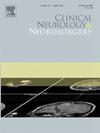从中线到动脉瘤的距离作为小型未破裂大脑中动脉动脉瘤手术缺血性并发症的简单预测指标。
IF 1.8
4区 医学
Q3 CLINICAL NEUROLOGY
引用次数: 0
摘要
背景:本研究旨在明确手术切除流行性小脑中动脉瘤(MCA Ans)时术后脑梗死的风险因素:本研究旨在明确手术切除流行性小型大脑中动脉动脉瘤(MCA Ans)时术后脑梗死的风险因素:这项回顾性研究纳入了2015年1月至2020年12月期间在我院接受直接手术治疗未破裂MCA动脉瘤的246例患者(平均年龄为64.8±10.0岁;男性占25.6%,女性占74.4%),共258个动脉瘤(平均动脉瘤大小为5.4±2.4毫米)。所有手术均在全身麻醉下进行,并结合吲哚青绿视频血管造影和经颅运动诱发电位以提高手术的精确性和安全性。通过术后一周内的 CT 扫描评估手术相关脑梗塞的发生情况,并与术前图像进行比较。根据术后中风与否对患者进行分类,并对患者的年龄、性别、既往病史、动脉瘤大小、使用的夹子数量以及中线到动脉瘤的距离进行分析:17名患者术后发生了脑梗塞(6.6%,有症状的6人,无症状的11人)。两组患者在年龄、夹子数量或动脉瘤大小方面无明显差异;但卒中组患者中线到动脉瘤的距离明显较短(27.1 ± 4.7 mm;P < 0.001),根据接收者操作特征曲线,临界值为 29 mm:结论:对 MCA Ans 进行手术切除时,动脉瘤位置越靠近中线,发生脑梗死的风险越高,这强调了将动脉瘤位置作为手术切除的风险指征的重要性。本文章由计算机程序翻译,如有差异,请以英文原文为准。
Distance from the midline to the aneurysm as simple predictor of ischemic complication with small unruptured middle cerebral artery aneurysm surgery
Background
This study aimed to clarify the risk factors for postoperative cerebral infarction in surgical clipping for prevalent small middle cerebral artery aneurysms (MCA Ans).
Methods
This retrospective study included 246 patients (mean age, 64.8 ± 10.0 years; 25.6 % males, 74.4 % females) with 258 aneurysms (mean aneurysm size, 5.4 ± 2.4 mm) who underwent direct surgery for unruptured MCA Ans at our institution from January 2015 to December 2020. All surgeries were performed under general anesthesia, incorporating indocyanine green videoangiography and transcranial motor-evoked potentials to enhance surgical precision and safety. The occurrence of surgery-related cerebral infarction was evaluated using postoperative CT scans within one week, comparing them with preoperative images. Patients were categorized based on the presence or absence of postoperative stroke and were analyzed for age, sex, past medical history, aneurysm size, number of clips used, and distance from the midline to the aneurysm.
Results
Seventeen patients had postoperative cerebral infarction (6.6 %, symptomatic 6, asymptomatic 11). There were no significant differences in terms of age, number of clips, or aneurysm size between the two groups; however, the distance from the midline to the aneurysm was significantly shorter in the stroke group (27.1 ± 4.7 mm; p < 0.001), with a cutoff value of 29 mm using the receiver operating characteristic curve.
Conclusion
Surgical clipping for MCA Ans presents a high risk of cerebral infarction for aneurysms located closer to the midline, emphasizing the importance of considering aneurysm location as a risk indication in surgical clipping.
求助全文
通过发布文献求助,成功后即可免费获取论文全文。
去求助
来源期刊

Clinical Neurology and Neurosurgery
医学-临床神经学
CiteScore
3.70
自引率
5.30%
发文量
358
审稿时长
46 days
期刊介绍:
Clinical Neurology and Neurosurgery is devoted to publishing papers and reports on the clinical aspects of neurology and neurosurgery. It is an international forum for papers of high scientific standard that are of interest to Neurologists and Neurosurgeons world-wide.
 求助内容:
求助内容: 应助结果提醒方式:
应助结果提醒方式:


